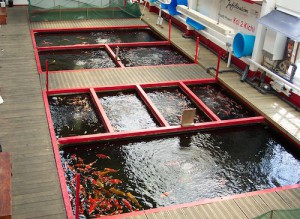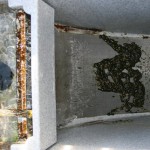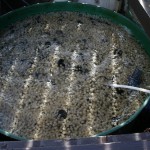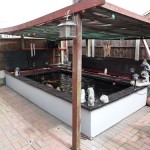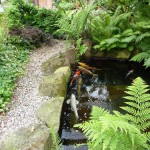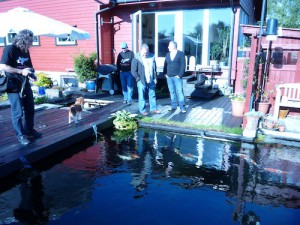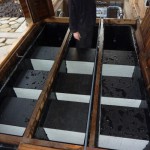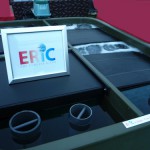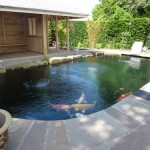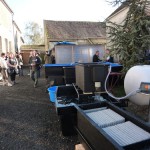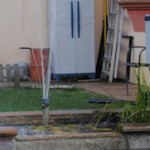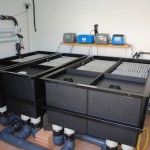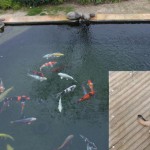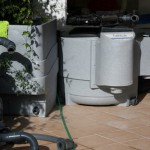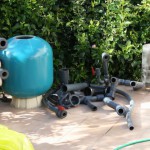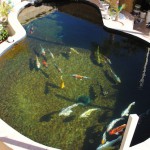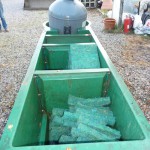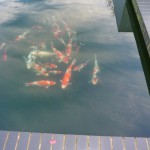A QUICK START GUIDE TO ERIC
There is so much information about ERIC pond filters on this website that it can prove to be be daunting to many readers, however this is true of many items today such as cars, computers, cameras and many other items we use. The clever manufacturers have already seen the light and know full well that the main instruction manuals supplied with these items would take an age to digest.
So now they also supply, together with the detailed manual, a ‘Quick Start Guide’ that covers the most important areas and enables the reader to get a ‘basic understanding’ of the product in question without taking up too much of the reader’s valuable time.
My ‘Quick Start Guide’ here, is the story of ERIC pond filters from day one and so it covers history; reasons for production; the units themselves; installation details; operation details and maintenance regimes together with several other details including testimonials.
Hopefully, after this ‘Quick Start’ guide has been read, the reader can check out any of the finer details, which are all covered on the main menu of this website.
I’m not documenting this to criticise any other brand of filter even if it may seem to be so and nor is it intended to be an advertisement as such. Instead I am just trying to explain the ‘ERIC Principle’ itself in comparison to other designs available on the market today.
So here it is right from the beginning.
INDEX
- The beginning
I had asked the Japanese Koi breeders endless questions as to the causes of hikui and shimi since the early…
- FILTRATION IN KOI PONDS
In the early 1980’s I was the first to produce ready-made multi-chamber upward-flow units simply as a ready-made…
- THE FUTURE OF FILTRATION
In ’86 I’d ‘stumbled’ on an unusual design for a budget filtration unit after I’d seen a tailored cartridge,…
- THE ERIC ARRIVED
After witnessing the success of this simple principle of ‘horizontal-flow’, I decided to look into it far more closely…
- ERIC INSTALLATION
If they are installed correctly (only a spirit level is required) and if they are maintained as specified it is impossible…
- ERIC MAINTENANCE
A word here about the cleaning regimes, it is absolutely VITAL that the 4” bore line to waste is not reduced…
The beginning
I had asked the Japanese Koi breeders endless questions as to the causes of hikui and shimi since the early ‘80’s and, without exception, all fingers pointed to the filter systems being used.
I have also asked three Japanese high-end collectors to why they keep all their best show Koi with the breeders they bought them from and not in their own ponds. The replies came back to say – that by keeping them with the breeders, their Koi did not contract hikui.
Bearing in mind that their mud ponds are only used for 90 days in a given year in order to produce maximum growth, the Koi are then kept for the remainder of the year in indoor concrete re-circulating systems. Although these indoor systems are strictly maintained on a daily basis they are still extremely dated by today’s standards.
The vast majority of breeders steer well away from pond system design as they employ others to design and install their concrete ponds; all the breeders do is give these guys the available ground space to work to.
For quite a few years, I’d assumed it was the magic of the mud ponds that did it all.
That’s until I realised that, after the Koi are placed into the mud ponds, the breeders empty the indoor systems and steam clean or scrub all pond and filter surfaces and all the media is taken out, cleaned thoroughly and then left to dry for the summer.
Then came the old fact that I had never seen hikui manifest itself in ponds that were less than 30 months old and the old fact that the breeders had pointed their fingers to blame the filter systems. It was then that I concentrated on the filters themselves bearing in mind the annual clean out of the breeder’s indoor systems.
In truth, the breeders have no idea what’s involved in keeping their stocks in a concrete system for longer than nine months. Instead they start with a brand new system every single year, whilst we Koi keepers have to keep them in our systems for many years.
- Hikui (HE-COO-EE)
- A Problem which has escalated in the UK since the late 1980′s and is causing concern with several collectors of high grade koi.
- This virus affects only the red pigmentation of Kohaku,Sanke and Showa varities and is more likely to affect those with high quality red pigmentation.
- It never occurs on other pigmentations or on any other variesties of Nishikigoi.
- Shimi
- It is not only Hikui that sometimes becomes present but also ‘shimi’ (black freckles on the beni pigmentation) at other times and, more importantly, the deterioration of the overall patterned skin of the Koi which becomes visibly ‘rough’ in appearance almost like fine sandpaper.
- For more information regarding Hikui and Shimi, please click the link (link opens in a new browser window).
Filtration in Koi Ponds
In the early 1980’s I was the first to produce ready-made multi-chamber upward-flow units simply as a ready-made copy of systems I’d seen in Japan – the Cockney Koi units sold today are exact copies of my early 80’s multi-chamber units. I continued to produce upward-flow units even right up into the mid 1990’s by way of my vortex design.
In ’85, I installed a large concrete system at Infiltration for extra sales ponds and the filter systems were made up of four upward-flow concrete chambers measuring 4’ x 4’ x 3’ deep and these were connected by wide transfer ports. The media used in the last two chambers was filter mat cartridges, heavily aerated from below. These chambers were covered with decking to allow customers to view the Koi.
I can’t recall exactly when I first noticed it but it was around the late 1990’s. The fact was that whilst the majority of the cartridge surfaces were covered in a thick brown dust, the only part of the chamber where the blue filter material could still be clearly seen was a small area right at the point where the water exited each chamber via the transfer port.
It was plain to see that the areas right next to each transfer port were the only areas getting the water flow and all other areas of the cartridges were useless simply because water was tracking directly from inlet to outlet – hence the layers of brown dust covering them produced by debris blown up by the aeration below and settling on the tops of the cartridges.
It was then that I realised for the first time just how inefficient upward-flow boxes actually were.
(For detailed explanations of this, please read ‘Flow Patterns’ on the main menu.)
The future of filtration
In ’86 I’d ‘stumbled’ on an unusual design for a budget filtration unit after I’d seen a tailored cartridge, made for a customer, that had been placed on it’s side awaiting collection. I then considered the possibility of getting water to pass through these cartridges horizontally instead of upwardly and this would save the expense of making separate chambers and transfer ports.
By late ’86, after a few teething hiccups, I produced my first ‘Budget Filter System’ and later gave it much space in ‘Koi Kichi’, which came out in ’95. I later gave the same design some space in Koi2Kichi in 2004.
It wasn’t until late 2008 that I really started to give serious thoughts to filtration systems after witnessing many disastrous results produced on the state of the Koi directly through both the designs of the popular systems of the day together with extremely poor attention to maintenance.
In early 2009 I was asked to design a large system from scratch and that’s when all my thoughts came together as to the worth of using horizontal-flow instead of the old upward-flow designs.
It then came to mind that I had sold many budget filter systems and had not had a single complaint although they had been discontinued for many years. In view of this, I contacted some people who had bought them and asked if I could go round to see them.
The second shot shows a pond that had been running problem-free and non-stop for 25 years.
By then I had designed some concrete DIY filter systems in other countries based on the original budget filter.
The ERIC Arrived
After witnessing the success of this simple principle of ‘horizontal-flow’, I decided to look into it far more closely.
There were many problems to be rectified with the old budget filter unit, some of these were the box dimensions; managing the brushes; a total re-vamp on aeration; the best material for the biological stages; getting maximum usage of the biological surfaces etc. but I was still going to promote it with a concrete outer box.
On New Year’s Eve 2009, I came up with the term ‘Endless River In Concrete’ and abbreviated it to ERIC.
The ‘2009 Pond from start to finish’ (link opens to external website) was the one that made me realise just how incredibly expensive it was to make perfect, watertight outer boxes for the filtration system, not only that, they took up far too much space and also were a pain to get the side walls to be perfectly straight and perfectly vertical.
I then decided to make a ready-made unit out of glass-fibre and tried it out once or twice.
That was equally as useless, simply because of the ‘draw-angle’ required on all glass-fibre moulds whereby perfectly vertical walls cannot possibly be achieved.
Whilst the ‘2009 Pond from start to finish’ IS a huge success as far as the condition of the Koi is concerned since it was started up in November 2009; building watertight outer boxes in concrete takes up far too much space and FAR too much money!
In late November 2009, the ready-made ERIC units were first launched with the boxes fabricated in polypropylene to allow for perfectly vertical walls that gave a perfect fit for the internal parts to drop inside.
ERIC Installation
If they are installed correctly (only a spirit level is required) and if they are maintained as specified it is impossible for them to fail, and I am convinced that, if maintained as specified, then hikui will no longer be a problem – time will tell!
The gravity-fed units all work on the painfully obvious principle of ‘One Drain to One Filter to One Pump’ and it is important that the drainage layout on the pond base is seriously thought out well before any filter systems are considered.
These units are stand-alone systems, nothing is required either before or after the unit itself and the suggested flow-rate through each unit is that the volume of water that each bottom drain is covering, passes through the unit once in approximately 2.5 hours.
As an example, in a single-drain system of 5,000-gallons, filtered by an ERIC Four unit, the flow rate through the filter will be 2,000gph.
Many have yet to grasp these facts about the system –
‘Horizontal-Flow’ is the most efficient and natural water flow pattern to adopt in order to supply incoming water to all biological media surfaces within the box. No other system manufactured advocates this unique method.
The biological media used is also completely unique. Although it is made by the self-same manufacturers of Japanese filter mat, it is 30% denser than the top quality filter mat which allows it to be produced in 19mm thicknesses rather than the standard 38mm thickness. This, in turn, allows for more surfaces within the block and one block of the grey material, in terms of surface area, is equivalent to three similar sized blocks made from the original blue material.
The ground volume (space) taken up in installing these units is FAR less than any other unit on the market simply because everything that’s required to service the unit is all contained inside the box itself.
Expensive underground filtration housings are no longer required.
All units can be stopped, emptied completely, re-filled and re-started in seconds with no discernable water level drop to the pond. This is not nearly possible with any other filtration design.
Should the need arise, both the mechanical and biological stages of all units can be removed and checked in minutes in order to see, with one’s own eyes, a brand new box below. They can be rinsed and replaced either left to right, right to left or even upside down and all this can be carried out in minutes. Once again, no other system has these huge advantages.
ERIC Maintenance
A word here about the cleaning regimes, it is absolutely VITAL that the 4” bore line to waste is not reduced or this will severely reduce efficiency.
I have no idea why many are under the impression that the one of the greatest added ‘values’ in any ready-made filter system is the time period between discharges that is specified by the manufacturer.
Seemingly, the longer the time period, the more ‘attractive’ the system becomes?
One thing I do know is that the vast majority of filtration systems I have seen have been sadly lacking in maintenance because the initial ‘novelty-value’ has been long forgotten and replaced with a chore. No one likes ‘chores’ and, as a result, some systems – especially the large, block-built, multi chamber ones are left untouched for months whilst other systems simply overflow when clogged.
To empty large, deep filter boxes and clean them thoroughly necessitates a huge amount of water being discharged to waste and this results in the pond level dropping far lower than the pick up of the water pump. Obviously, until new water gets the level back to normal the system is shut down and these clean-outs can easily take the best part of a day to carry out.
It’s painfully understandable as to why this is looked upon as a chore and I also understand why the owners are very reluctant to do this with any regularity.
The truth is, all pond filters are simply ‘pond lavatories’ and lavatories need to be flushed after use.
The ‘lavatories’ that are our pond filters are in the ‘ENGAGED’ position from the moment the water pump is switched on and from that moment they are in a constant state of deterioration. This is the reason I strongly recommend that all my units are completely discharged to waste every 24 hours – although it is virtually impossible to ‘block’ them by leaving them without attention.
If ANY water should be dumped daily, it is the water from the lavatory and ALL of it, not just a PART of it.
The difference with these filtration units is that, unlike any other on the market, this can be done in seconds, rather than hours, and there is really no visible drop in pond water level after the dump has taken place. This is simply because the shallow, narrow units themselves hold very little water and the 4” bore drain to waste removes it all to the sewer very quickly indeed.
I do recommend that a ‘constant trickle’ of mains water be used to replace water that has been dumped rather than ‘topping up’ the system in one hit. There is an overflow facility on all units that will handle any excess water and take it to waste.
The simple brush box holds the purpose-made filter brushes rigidly in position at all times and it’s the first time I have ever seen filter brushes used correctly as intended. In any single 24-hour period together with high stocking and feeding rates and in high water temperatures it is difficult for mechanical waste matter to go past even the first row of brushes and the daily flush removes all of that by the release of the 4” standpipe to sewer.
The main ‘secret’ behind it all is the curtain of heavy aeration by way of long, membrane diffusers that service the entire width of the boxes at specified intervals in tiny gaps before and after each biological block. The vertical ‘confusion’ produced to the horizontal-flow water passing through ensures that there are no ‘normal’ layers of water within the ‘river’ and thus, with the aid of the final circular baffle, the entire body of water travels endlessly as a ‘block’ – hence my term ‘The Endless River’.
I have often been asked as to the units that were replaced by installation of these systems,
Close neighbours to this pond ordered the ERIC units after first witnessing this system personally and the simple cleaning regimes required.
Several other ponds have suffered water clarity and quality problems together with laborious maintenance chores with huge losses of water.
By having a squeaky-clean filter system on a daily basis, I believe that the results will be even better than the annual clean out adopted through necessity by the Japanese breeders.
If this IS the case and no hikui or shimi are produced then the conditions will not simply benefit high quality Koi, they will also benefit ALL qualities of Koi by way of producing much better water and water conditions.
I have tried to be as brief as possible without leaving anything of major importance out. If further information is required, it is far more detailed on the Eric website.
I didn’t do any blanket advertising worldwide and nor did I open a factory to make ‘em in and then pass that cost on in the end price to the customer.
Believe me, I have been there before; I have done that before and have got all the tee shirts from before.
I’ll take my chances with good old ‘word of mouth’ instead – the very best form of advertising and promotion in the world!

